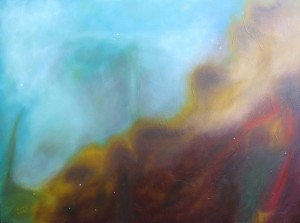Press → Nebula Paintings, a Convergence of Science and Art
Scientific Hubble Space Discoveries Inspire the Abstract ‘Fairy-Cloud’ Paintings of Vancouver Colourist Stacy Sakai – by Dr. Lycia Trouton
Saturday, December 20th, 2008
Nebula Paintings, a Convergence of Science and Art

Omega Swan
Science has inspired artists for centuries, since Leonardo Da Vinci was accepted as the Renaissance man, or ‘Polymath: The Learned One’, knowledgeable in many fields. These days artists of all sorts, especially conceptual artists, consider it ‘de rigeur’ to apply “Concepts through Visual and Material Culture”.
Stacy Sakai, a Vancouver painter, has based her 2008 series of contemporary paintings on beautifully poetic and abstract imagery of ‘nebulae’, or cloud dust! Her paintings are rich with deep colours and no apparent form. These are not conceived as modernist abstract expressionism; Sakai was interested in documenting the scientific discovery of nebulae from space ‘photographs’.
Unlike the fairy dust that artistic people of all sorts dream about capturing around us, especially as children – Sakai’s cloud-fairy-dust paintings are reproduced from digitally-imaged, light-recording devices of the Hubble Space Telescope! In speaking with the artist, Sakai stated:
After learning about oil painting from my father while growing up in South America, and later from my grandmother, I have since been involved in the art industry in North America for many years. Since 2000, I have exhibited my paintings in Vancouver, Canada, and assisted with art shows and live performance in New York City. All across the Americas we can view the sky, and the Hubble Space Telescope is a good metaphor for linking the fragile dreams of citizens-of-all-colours, in both northern and southern hemispheres.
According to the Hubble website, nebulae are digitally recorded using:
Special electronic detectors, which produce images in shades of black and white. The colour images are combinations of two or more black and white images to which colour has subsequently been added during the image processing.
Yet, her colours are not necessarily a true representation of the actual nebula. She is not illustrating specifically for a scientific audience-reader. As a painter, Sakai has taken the liberty of experimenting with the scientific imagery and colours as ‘viewing tools’ to enhance the data that she is processing and presenting to a very different art market viewer. Sakai takes this scientific data — of an electromagnetic, light-emanating spectrum and delivers it in a colourful, visual form for aesthetic consumption and enjoyable processing for her art viewers.
Did you know that the Hubble Space Telescope, which Sakai is interested in, circumnavigates the earth every 97 minutes, at a speed of 8 kilometers per second, as stated by the Hubble website?! The exact latitude and longitude of the Hubble Space Telescope, at any time, is documented on a ‘fun-facts’ web page for children!
Sakai uses her scientific study to create poetic paintings about timeless celestial beings. In doing so, she is expressing almost intangible, ancient emotions and an artistic preoccupation with sky/seascapes, common landscape subject matter throughout art history and, especially, since Romanticism language.
In contemporary times, Yoko Ono (b. 1933) made this point particularly relevant in the 1970s in her pioneer conceptual performance and installation art about ‘the cosmos’ which often, indirectly, references Ono’s childhood experience of watching the sky during the fire bombing of Tokyo, March 9, 1945.
Like Ono, Sakai’s early interest in astronomy developed in childhood. The sky is a universal phenomenon, available for viewing from all places of the globe; ‘the sky’ does not discriminate between country, ethnicity, and/or political viewpoint of the viewer for the location, context and time-space constraints through using the metaphor of nebulae. Thus, the Hubble Space Telescope images help her to produce strongly compelling emotions in a painterly technique, and yet remain objective in order to alter the artworks according to techniques.
By painting nebulae, Sakai focuses on being a type of colourist, yet scientific at the same time – and (with more involvement in her conceptual and academic approach), perhaps Sakai will become one of a new breed of emerging practice-led ‘artists-as-researchers’.

In 2009, Stacy Sakai is working on her next series entitled “Spacescapes.”
ENDNOTES:
(Date and page accessed may be supplied upon request.)
Artist Yoko Ono: ‘Between the Sky and my Head’ 2009 www.balticmill.com/yokoono/
www.hubblesite.org
http://en.wikipedia.org/wiki/Leonardo_da_Vinci
http://en.wikipedia.org/wiki/Romanticism
Dr. Lycia Trouton is the Co-founder of ArtistRun and ArtConverge. She is also a writer, public artist and presenter. Read more about Lycia at www.artistrun.org